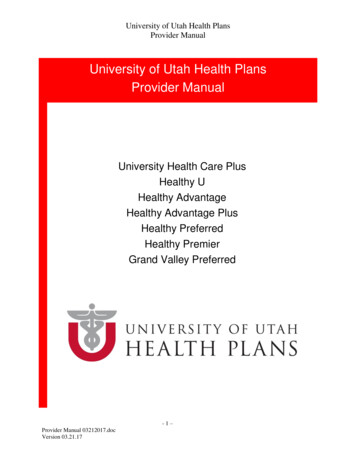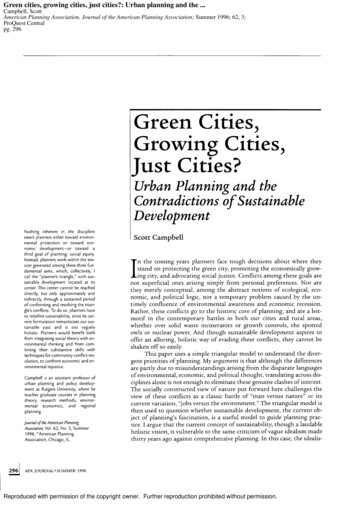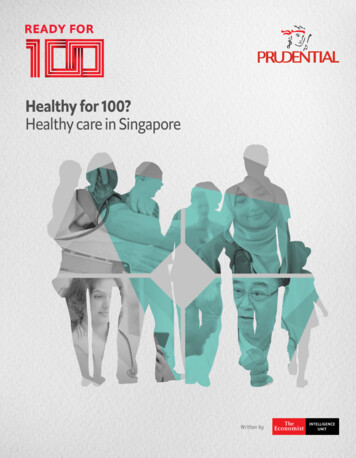
Transcription
Basic Principles of Healthy Cities : Community DiagnosisBasic Principles ofHealthy Cities:CommunityDiagnosis1
Basic Principles of Healthy Cities : Community DiagnosisHealthy Cities Project (HCP) has been launched in most of the districts in HongKong and is expected to expand in the future. The success of HCP requires thorough and strategicplanning. Community diagnosis is a useful tool to assist in this work.What is community diagnosis?According to WHO definition, it is “a quantitative and qualitative description of the health ofcitizens and the factors which influence their health. It identifies problems, proposes areas forimprovement and stimulates action”. The practical relevance of community diagnosis in HCPincludes:-to act as a data reference for the district-to provide an overall picture of the local community and the residents’ concerns-to suggest priority areas for intervention and the feasible solutions-to indicate the resource allocation and the direction of work plans-to create opportunities for intersectoral collaboration and media involvement-to form basis of setting indicators for HCP evaluationHow to conduct community diagnosis?The process of community diagnosis involves four stages:1. Initiation2. Data collection and analysis3. Diagnosis4. Dissemination2
Basic Principles of Healthy Cities : Community Diagnosis1. InitiationIn order to initiate a community diagnosis project, a dedicated committee or working groupshould be set up to manage and coordinate the project. The committee should involve relevantparties such as government departments, health professionals and non-governmentalorganisations.At an early stage, it is important to identify the available budget and resources to determine thescope of the diagnosis. Some of the common areas to be studied may include health status,lifestyles, living conditions, socioeconomic conditions, physical and social infrastructure,inequalities, as well as public health services and policies.Once the scope is defined, a working schedule to conduct the community diagnosis, productionand dissemination of report should be set.2. Data collection and analysisThe project should collect both quantitative and qualitative data. Moreover, Population Censusand statistical data e.g. population size, sex and age structure, medical services, public health,social services, education, housing, public security and transportation, etc. can providebackground of the district. As for the community data, it can be collected by conductingsurveys through self-administered questionnaires, face to face interviews, focus groups andtelephone interviews.In order to ensure reliability of the findings, an experienced organisation such as an academicinstitute can be employed for conducting the study. The sampling method should be carefullydesigned and the sample size should be large enough to provide sufficient data to draw reliableconclusions. Therefore, study results derived can truly review the local community.Collected data can then be analysed and interpreted by experts. Here are some practical tips ondata analysis and presentation:-statistical information is best presented as rates or ratios for comparison-trends and projections are useful for monitoring changes over a time period for futureplanning-local district data can be compared with other districts or the whole population-graphical presentation is preferred for easy understanding3
Basic Principles of Healthy Cities : Community Diagnosis3. DiagnosisDiagnosis of the community is reached from conclusions drawn from the data analysis. Itshould preferably comprise three areas:-health status of the community-determinants of health in the community-potential for healthy city development4. DisseminationThe production of the community diagnosis report is not an end in itself, efforts should be putinto communication to ensure that targeted actions are taken. The target audience for thecommunity diagnosis includes policy-makers, health professionals and the general public in thecommunity.The report can be disseminated through the following channels:-presentations at meetings of the health boards and committees, or forums organised forvoluntary organisations, local community groups and the general public-press release-thematic events (such as health fairs and other health promotion programmes)It is important to realise that CommunityDiagnosis is not an one-off project, but is partof a dynamic process leading to health promotion in the community. Therefore communitydiagnosis should be conducted at regular intervals to allow the HCP be continuously improved.4
Basic Principles of Healthy Cities : Community DiagnosisA flowchart describing the community diagnosis process5
Basic Principles of Healthy Cities : Community DiagnosisLocal examples and useful informationYou may visit the following websites for some local examples of community diagnosis reports.-Eastern .html-Tai Powww.tpshc.org/englishsite1/index.phpMoreover, statistical information related to the health of our population can be accessed atwww.healthyhk.gov.hk, a website of the Department of Health.References1.World Health Organization. City Health Profiles: how to report on health in your city.ICP/HSIT/94/01 PB 02. Available at:www.euro.who.int/document/wa38094ci.pdf2.Garcia P, McCarthy M. Measuring Health: A Step in the Development of City Health Profiles.EUR/ICP/HCIT 94 01/PB03. Available at:www.euro.who.int/document/WA95096GA.pdfCopies of this leaflet are available from the Community Liaison Division.Please direct request to ha2 cld2@dh.gov.hk.This leaflet is also accessible at the Central Health Education Unit’s website www.cheu.gov.hk andCentre for Health Protection’s website www.chp.gov.hk.This leaflet was last updated in April 2009. For moreinformation, please contact the Community Liaison Division of Updated in April 2009the Health Promotion Branch of the Department of Health byemail at: cld@dh.gov.hk.6
- health status of the community - determinants of health in the community - potential for healthy city development 4. Dissemination The production of the community diagnosis report is not an end in itself, efforts should be put into communication to ensure tha










